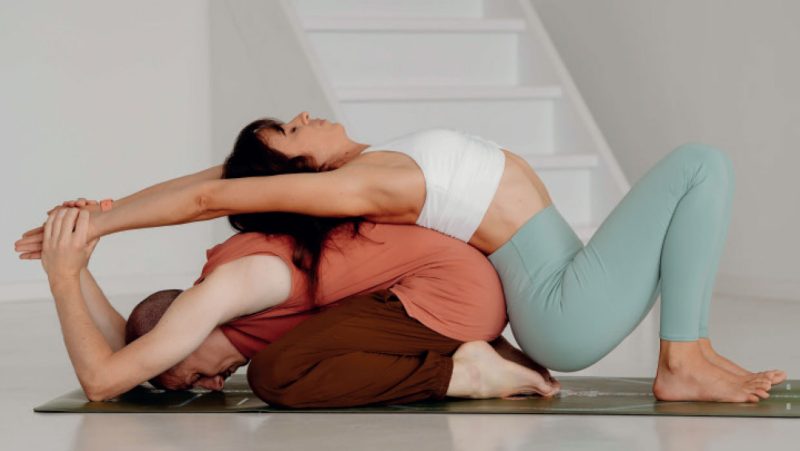Don’t skip your savasana, writes Sarah Williams, it may just be the most important part of your practice.
Technology has us in its grip: “I’ll just check my bank balance” (at 2am!); “I’ll just order it from amazon” (right before going to sleep!); “I must reply to that email” (during dinner!); “I must update my social media posts” (while spending ‘quality’ time with my partner!).
If you’re guilty of these then it’s likely you’re getting a little too much ‘on’ time and not enough ‘off’ time. You may have a daily yoga practice which helps put this ‘busy-ness’ and screen time into context, but, what’s the one thing in your yoga practice that often suffers when you’re this busy? Savasana.
If stressed out and overtired is your norm, an extended savasana practice could be the missing link to settling both body and mind. The stress response is an important and necessary part of our nervous system. But if you are constantly speeding ahead, you have lost the ability to regulate between sympathetic nervous system (the flight-or-fight response), and parasympathetic nervous system (the rest-and-digest response).
While it’s not as simple as just hanging out in the wrong part of the nervous system, stimulating the relaxation response is essential to overall wellbeing. Being over stimulated with caffeine and screens won’t trigger the relaxation response – but savasana can.
If you lie down in savasana at the end of an active practice and feel you don’t have ‘time’ to do the pose then it may be time to re-evaluate your rest and self-care.
Why do I need savasana?
When you facilitate the right environment for your body to relax, your muscles will release and your blood pressure and stress hormone levels will drop. Your heart rate, breathing and brain waves will slow down.
This sounds great, but it may take time to achieve this, especially if you are newer to the practice.
What do you need in order for this posture to work its magic? A supported, reclined position to help the body to feel comfortable. Darkness, warmth and a good length of time will begin to let you unravel into ease. It goes without saying that if you are not comfortable, you won’t relax, so creating the correct environment to rest is paramount.
It is important to note that this form of resting is very different to sleeping. We experience physical rest during sleep but muscles and stress hormones can remain turned on
How often do I need to do savasana?
The more frequently you do something the more new neural pathways will be created. Creating healthy samskaras and habits in this way happens because the brain is constantly re-modelling itself. The more you do something, the stronger those new pathways become.
Think about learning to play the piano: the brain takes time and persistent practice to learn this new skill. So starting to plan an achievable and consistent practice will be key to reaping the benefits physically, emotionally and mentally.
During the practice, bearing witness to the exhalation can help to stimulate the vagus nerve as the heart rate decreases. The vagus nerve is a key component of your parasympathetic nervous system as it influences your breathing, digestion and heart rate. Eventually, the brain waves will slow down in savasana.
Don’t expect quick fixes, this practice will evolve over time. The more time you invest, the more comfortable it will become to stay where you are and with who you are.
How do I practice savasana?
It can be useful to start working backwards when planning your practice. If you know that you only have 30 minutes, still set aside 20 minutes for savasana. There may well be resistance to only having 10 minutes to move beforehand initially, but it’s important to remember that your yoga practice is not a workout.
Recognise that it is as important to prioritise stillness as much as movement and right now you are trying to develop new positive habits. Carve out more time by omitting social media and screen time.
Make sure that you have a quiet space and a firm, comfortable surface to lie on (a yoga mat or a blanket will do).
Try not to do this in bed, especially if you’re one of those ‘fall asleep on your nose’ people. You need the right set-up to hold you so that you can’t help but relax.
Here are a few other tips:
LOWER BACK: supporting the back of the knees allows the hip flexors on the front of the body to slacken letting the lumbar spine settle into neutral.
EYES: having the eyes covered with a light weight such as an eye pillow stimulates the oculocardiac reflex. Gentle pressure on the eyeballs/brow facilitates the relaxation response by reducing heart rate. Just remember that a gentle amount of pressure is best.
NECK: having a little support for the neck can stop it from overextending. It’s a good idea to have a folded blanket under the head to ensure that the chin isn’t higher than the forehead. You may want to add a folded/rolled hand towel under the curve of your neck for extra support.
TEMPERATURE: make sure you are warm as your body temperature may drop when you stay in the pose for a sustained period of time.
GIVE YOURSELF ROOM: Set yourself up away from a wall so that nothing is touching your body. You want to feel spacious and have room to expand in the pose.
Bear in mind that the beginning of your savasana may feel a little frustrating. Learning to let this happen and stick with it is part of the practice. Completely letting go can be a hard concept to experience for some people so imagine turning a dimmer switch down gradually.
Savasana doesn’t really start until body and mind have relaxed. Your body will begin to rest deeply and your mind will become an observer over time.
At the end, make sure you take plenty of time to come out of the pose by rolling to one side first.
Note how you feel. Having a comparison to reflect on can be useful for future practices and can help you become more accustomed to observing how you feel before and after practice.
Sarah Williams is a yoga teacher, musician and writer. She teaches classes, workshops and retreats in Brighton, London and internationally (sarahwilliamsyoga.com)







